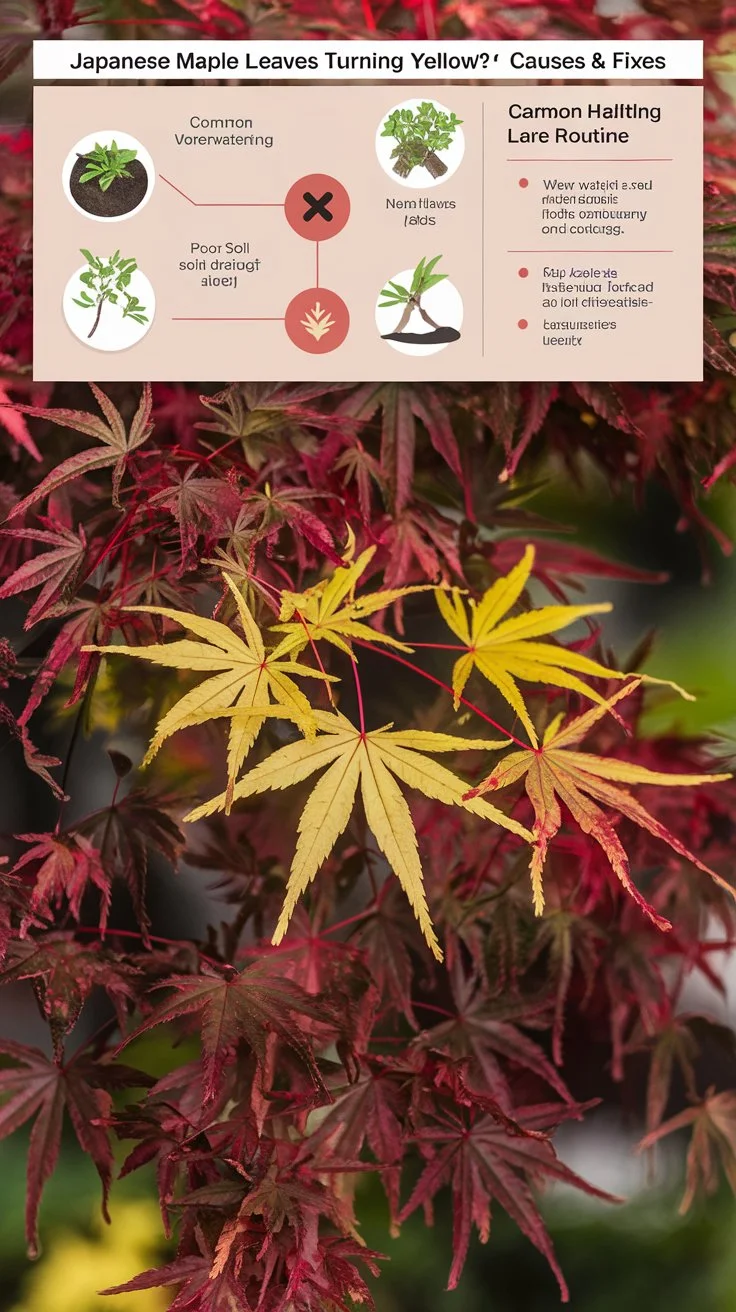Discover why your Japanese maple leaves are turning yellow and learn expert solutions. Address overwatering, nutrient deficiencies, and environmental factors to restore your tree’s health.
Japanese maple leaves (Acer palmatum) turning yellow can be caused by various factors including overwatering, nutrient deficiencies, environmental stress, or pest infestations. Identifying the specific cause and applying appropriate solutions can help restore your tree’s health and vibrant foliage color.
Hello, I’m Ashley Scott, an arborist with over 15 years of experience in tree care and maintenance. Today, I’ll guide you through the common causes of yellowing leaves on Japanese maples and provide practical solutions to help your tree regain its beautiful foliage.
Understanding Japanese Maples and Leaf Discoloration

Japanese maples are prized for their delicate, colorful foliage and elegant structure. When their leaves turn yellow (a condition known as chlorosis), it’s a sign that something is amiss. Let’s explore the potential causes and solutions.
Common Causes of Yellowing Leaves
1. Overwatering
Excessive moisture can lead to root rot and nutrient deficiencies, causing leaves to yellow. Japanese maples prefer well-draining soil and consistent, but not excessive, moisture.
Solution: Adjust your watering schedule and improve soil drainage. Consider installing a smart irrigation system to optimize watering.
2. Nutrient Deficiencies
Yellow leaves, especially between the veins, often indicate a lack of essential nutrients like iron, manganese, or nitrogen.
Solution: Conduct a soil test and amend the soil with appropriate fertilizers. The University of Massachusetts Amherst offers excellent guidance on nutrient management for trees and shrubs.
3. Environmental Stress
Japanese maples are sensitive to environmental changes. Factors like extreme temperatures, high winds, or sudden frost can cause leaf discoloration.
Solution: Provide protection from harsh elements using shade cloths or wind barriers. Consider companion planting with other Japanese garden plants to create a more stable microclimate.
4. Pest Infestations
Pests like spider mites or scale insects can cause yellowing and other leaf damage.
Solution: Regularly inspect your tree and use appropriate organic pest control methods. Introducing beneficial insects can be an effective natural pest control strategy.
5. Soil pH Imbalance
Japanese maples prefer slightly acidic soil (pH 5.5-6.5). Soil that’s too alkaline can lead to nutrient deficiencies and yellow leaves.
Solution: Test your soil pH and adjust it using organic matter or sulfur to lower pH if necessary. The Clemson Cooperative Extension provides detailed information on changing soil pH.
6. Sunburn
While some Japanese maple varieties can tolerate full sun, many prefer partial shade. Excessive sun exposure can lead to leaf scorch and yellowing.
Solution: Provide adequate shade, especially during hot afternoons. Consider using shade sails or strategically placed larger plants for protection.
Preventative Measures and Long-term Care
To maintain healthy Japanese maples and prevent yellowing leaves:
- Proper Watering: Use a moisture meter to ensure consistent, appropriate watering.
- Regular Fertilization: Apply a slow-release, balanced fertilizer formulated for acid-loving plants in early spring.
- Mulching: Apply a 2-3 inch layer of organic mulch around the base of the tree, keeping it away from the trunk.
- Pruning: Remove dead or diseased branches to improve air circulation and overall tree health. The Royal Horticultural Society offers a comprehensive guide on pruning Japanese maples.
- Winter Protection: In colder regions, protect your Japanese maple from winter damage by wrapping it or using anti-desiccant sprays.
When to Seek Professional Help
If you’ve tried these solutions and your Japanese maple’s health doesn’t improve, it may be time to consult a certified arborist. They can provide a thorough assessment and specialized treatment plans.
Yellowing leaves on your Japanese maple can be concerning, but with proper diagnosis and care, you can often restore your tree’s health and vibrant color. By addressing issues like overwatering, nutrient deficiencies, and environmental stressors, you’ll be well on your way to maintaining a beautiful and thriving Japanese maple in your garden.
Remember, each tree is unique, and what works for one might not work for another. Patience and consistent care are key to nurturing these elegant trees. With the right approach, your Japanese maple can remain a stunning focal point in your landscape for years to come.
For more gardening tips and plant care guides, visit usagardenhub.com




One comment on “Why Are My Japanese Maple Leaves Turning Yellow? Common Causes and Solutions”